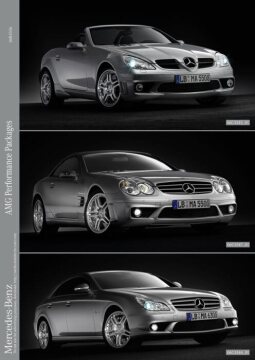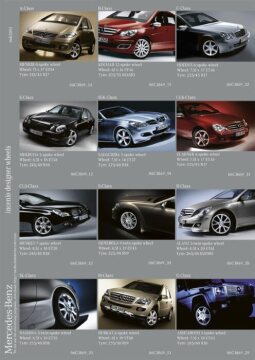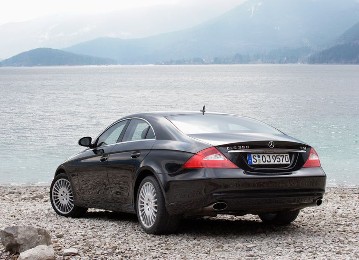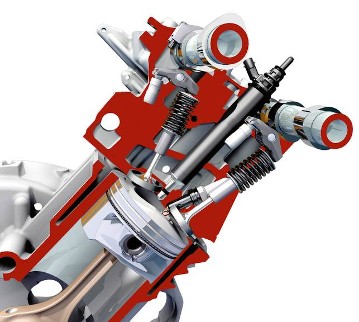Four years after their market launch, the C 219 coupés underwent a facelift in March 2008. The CLS-Class - pioneer of a new automotive segment - was made even more attractive through selective fine touches. The new entry-level engine version, the CLS 280 with a state-of-the-art V6 engine, produced 170 kW (231 hp). The top-of-the-line model, the CLS 63 AMG with a 378 kW (514 hp) AMG 6.3-litre V8 engine, now came with 19‑inch AMG light-alloy wheels and a new AMG sport exhaust system.
The restyling of the CLS was deliberately understated. A striking feature at the front was the modified radiator grille, which now had two instead of the previous four louvres. Diamond-shaped, three-dimensional and atlas-grey painted gratings in the air openings lent the front view an air of even greater confidence while additionally emphasising the width of the vehicle. The rear-view mirrors had also been redesigned, the integral LED side turn signals being arrow-shaped to create an especially appealing effect in the dark. In addition, the 32 per cent larger mirror area afforded a better view of following traffic and therefore greater active safety.
Newly designed 17-inch light-alloy wheels (CLS 280, CLS 320 CDI and CLS 350 CGI) or an 18-inch version (CLS 500) dominated the side view. Viewed from behind, the new-generation CLS drew attention to itself with a new rear apron, new tail lamps and modified exhaust tailpipes. The rear bumper was drawn down deeper in the middle area and emphasised the width of the vehicle with the additional horizontal imaginary intersection. This impression was supported by trapezoidal instead of the previously oval exhaust tailpipe trims. The new body details superbly harmonised with the multiple award-winning styling of the CLS and made the four-door coupé seem poised to leap. Nearly four years after its world debut, the trend-setter's exciting and powerful design still appeared unique and unmistakable.
The rear lamps now featured LED technology: brake, tail and turn-signal lamps came with especially quick-reacting light-emitting diodes. Like the side turn signals in the outside mirrors, the rear turn signals were arrow-shaped, creating an interesting play of light, especially in the dark. The same applied to the lateral optical fibres, which were always active when low beam was on. A new low beam deactivation function when the ignition was off made for optimal energy management.
The interior, too, was updated with an eye for detail, including a redesigned three-spoke leather steering wheel with multifunction buttons as well as a new-look instrument cluster. The white dials, for example, provided a varied contrast with the chiselled surface of the backplate. New touches of chestnut wood replaced the matt laurel colour scheme. The CLS came with the new NTG 2.5 telematics generation. The high-performance equipment combined simple operation and logical menu navigation with outstanding entertainment properties. It offered such features as speed-dependent volume control, a keypad for entering phone numbers and radio frequencies, an MP3-capable CD and DVD player as well as a Bluetooth interface for wirelessly connecting a mobile phone to the hands-free system. Audio 20, Audio 20 CD with CD changer, Audio 50 and Audio 50 APS with DVD changer and LINGUATRONIC voice control system now came with a five-inch colour monitor. The COMAND APS had a high-resolution 6.5-inch colour display, LINGUATRONIC for audio, navigation and telephony, a music register for storing audio files and an SD memory card slot.
A new entry-level engine version for the CLS 280 was the state-of-the-art V6 with 2,996 cubic centimetres displacement, a maximum output of 170 kW (231 hp) and a peak torque of 300 Newton-metres.It enabled the CLS 280 to accelerate in 7.7 seconds from 0 to 100 km/h with a top speed of 245 km/h. The combined consumption in the NEDC driving cycle was 9.8 to 10.0 litres per 100 kilometres. The CLS 350 CGI continued to be available as a second V6 petrol-engined version. Its advanced six-cylinder engine with piezo direct injection and spray-guided combustion delivered 215 kW (292 hp) with an impressively low fuel consumption of 9.1 to 9.3 litres per 100 km (NEDC combined). The CLS 500 was powered by a V8 engine with 5.5-litre displacement and a maximum output of 285 kW (388 hp). The CLS 320 CDI with the 165 kW (224 hp) V6 diesel engine was impressed especially with its high torque of 540 Newton-metres and low consumption of 7.6 to 8.1 litres of diesel fuel per 100 kilometres (NEDC combined). All CLS models came as standard with the 7G‑TRONIC seven-speed automatic transmission. In "M" manual shift mode, the driver could change gear as desired using the steering wheel shift paddles. This shortened the acceleration from 0 to 100 km/h by up to 0.2 seconds.
The top-of-the-line model of the CLS‑Class, the CLS 63 AMG, was powered by the AMG 6.2-litre V8 engine with 378 kW (514 hp) and 630 Newton-metres of torque. Audibly, the high-speed naturally aspirated engine was even more distinctive than before: newly designed rear silencers on the AMG sport exhaust system provided an even more fascinating sound, which escaped through the two chrome-plated, oval dual tailpipes. The AMG SPEEDSHIFT PLUS 7G-TRONIC now came with an automatic double-clutching function during downshifts. This not only enhanced the driver's emotive experience - practically load-free downshifting also reduced the load change reactions, which had a positive effect especially when braking before cornering on a race track. The CLS 63 AMG accelerated from 0 to 100 km/h in 4.5 seconds, the top speed being electronically limited to 250 km/h. Another innovation was the black-painted radiator grille with two instead of previously three louvres; it blended in perfectly with the AMG styling. Nineteen instead of the previous 18 inches were the new three-spoke, titanium-grey, high-sheen AMG light-alloy wheels with tyres of size 255/35 R 19 at the front and 285/30 R 19 at the rear. Inside, the CLS 63 AMG sported a new three-spoke AMG sport steering wheel. The specially formed grip area was covered with perforated leather. Two aluminium AMG shift paddles allowed manual gear selection. Exclusively available for the CLS 63 AMG were new extras from the AMG Performance Studio: such as the reduced-diameter AMG Performance steering wheel with flattened bottom and silver-coloured aluminium shift paddles as well as high-quality forged, titanium-grey painted AMG 19-inch light-alloy wheels with a double-spoke design and polished surface.
All CLS models were upgraded with AMG styling, including a distinctive front skirt with large cooling air outlets, a beefy rear apron with black insert and side skirt panels. In addition, new AMG 19-inch light-alloy high-sheen wheels were available with 255/35 or 285/30 tyres.
In March 2009, the CLS Grand Edition Mercedes‑Benz posted another highlight in the four-door premium coupé segment. Matt designo paintwork impressively shaped the lines of the coupé, turning the CLS Grand Edition into a genuine eye-catcher. This exclusive style continued through the interior with stylish designo leather and high-quality interior touches. In this way, the coupé underscored its distinctiveness, going on to win multiple awards. Grand Edition customers could choose between the metallic colours obsidian black, iridium silver, carneol red and flint grey. The additional exterior equipment of the CLS Grand Edition comprised bi-xenon headlamps with dark headlamp housings, active curve illumination and cornering lights function in the front fog lamps, headlamp cleaning system and dynamic headlamp range control. There were also exclusive 18-inch AMG light-alloy wheels of five-spoke design, painted in titanium grey and high-sheen, with tyres of size 245/40 R 18 (front) and 275/35 R 18 (rear). The no-frills elegance was continued through the interior, where a perfectly coordinated designo interior with an inner headliner in anthracite Alcantara and standard glass tilting/sliding roof characterised the sporty yet elegant style. A particular highlight was the designo leather upholstery in maroon, the colours sand, black, mystic red, porcelain and Chablis also being available. The trim parts of high-grade laurel wood were either matt or high-gloss. The selector lever and wood/leather steering wheel were made of the same material. Brushed stainless-steel sport pedals with rubber naps emphasised the sporty character of the CLS Grand Edition. The comprehensive equipment specification included the state-of-the-art COMAND APS Multimedia operating and display system, comfort telephony, PARKTRONIC and velour floor mats with "Grand Edition" stitching. The CLS Grand Edition was available in four engine variants (CLS 280, CLS 320 CDI, CLS 350 CGI and CLS 500).











































